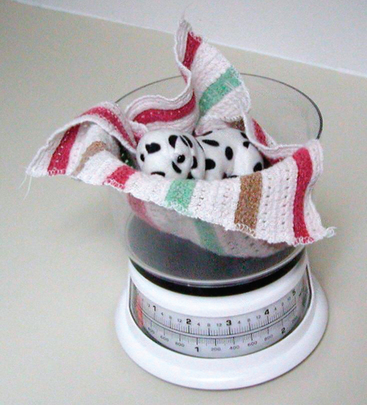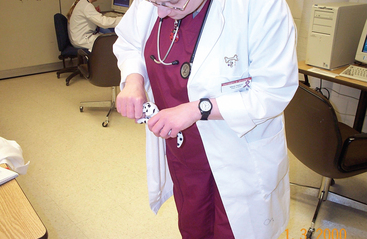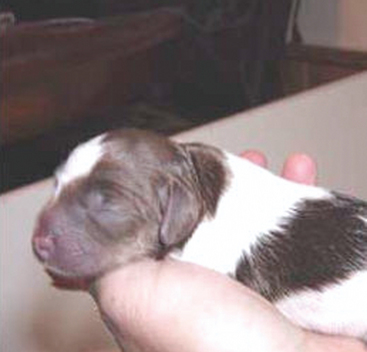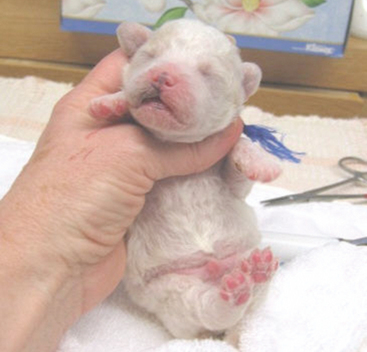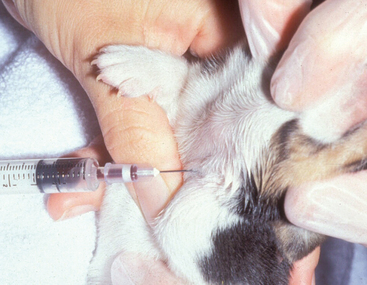13 Neonatology
Some authorities consider the neonatal period as the time until the eyes open and the pup is mobile, about the first 3 weeks of life. After that time, pups can spend more time away from the dam and attempts to “potty-train” the pups and wean them can begin within several weeks (Figure 13-1). This chapter addresses problems of puppies until about 8 weeks of age, or weaning. After that time, most body systems have achieved adult function and puppies can be diagnosed and treated as adults.
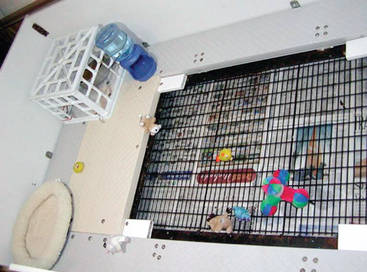
Figure 13-1 Pup housed with central grated area to promote “potty-training.”
(Courtesy Mary McKennan.)
Puppies are born with reduced function of the immune system, kidneys, and liver compared with adults. They have little body fat, decreasing their ability to control their own body temperature and altering how they metabolize and store nutrients from normal metabolism and drugs introduced for therapy. Their heart does not respond as quickly as it does in adult animals, altering their ability to tolerate fluid therapy and changing their innate response to alterations in oxygen and carbon dioxide content in blood. This changes how we interpret physical examination and laboratory findings in puppies and changes how and with what we treat puppies.
I. PHYSICAL EXAMINATION OF THE NEONATE
The puppy should have been weighed at birth and should be weighed once daily thereafter (Figure 13-2). Puppy birth weight varies by breed; estimates for various breeds are 4.2 oz (120 g) for Pomeranians, 9 oz (250 g) for beagles, 17 oz (490 g) for greyhounds, and 22 oz (625 g) for Great Danes. Slight weight loss may occur in the first 24 hours of life. After that, the puppy should gain weight daily, doubling its birth weight by about 7 to 10 days of age.
Rectal temperature varies with age and environment. Normal rectal temperature is 96.0° ± 1.5° F (35.6° ± 0.7° C) in the first week of life, 98.6° to 100.0° F (37.0° to 38.2° C) in the second and third weeks of life, and gradually rises to adult levels by the age of 7 weeks.
In the first 2 to 3 weeks of life, puppies spend most of their time sleeping. They huddle together or near the dam and will not ordinarily sleep apart from littermates or the dam until 5 to 6 weeks of age (Figure 13-3). When awake, neonates suckle vigorously. During examination, normal puppies are easily encouraged to suckle the examiner’s fingers or to root against the examiner’s encircled thumb and forefinger (Figure 13-4). Normal neonatal puppies can crawl, suckle, vocalize if distressed, and respond to odor, touch, and pain (Figure 13-5). Assessment of poor muscle tone or observation of decreased activity should prompt veterinary intervention. Pediatric animals that are observed to lie apart from littermates or the dam, cry excessively, are extremely restless, or lying still and nonresponsive should be examined by a veterinarian immediately.
The umbilicus falls off or is removed by the dam at 2 to 3 days of age. The umbilicus should be examined for evidence of infection. Traumatic inflammation of the appendages may occur if littermates are suckling on each other. Dehydrated pediatric animals exhibit more wrinkling and less turgor of the skin and deepening of the red color of the ventral abdomen and muzzle. Be aware that normal pups may have quite deep pink coloration of the ventral abdomen and muzzle for the first 5 to 7 days of life (Figure 13-6). Other signs of dehydration include dryness of the eyes and oral mucous membranes and a visible yellow color of the normally dilute urine.
The deciduous teeth are present by 6 weeks of age. Permanent teeth erupt, displacing the deciduous teeth, at 4 to 6 months of age. The small incisors in the front are lost first, and the large canine teeth are replaced last.
II. FIRST AID FOR NEONATES
Pups must be fed a nonmilk diet until rewarmed to prevent pooling and spoilage of milk products in their stomach. High-calorie supplements are available commercially. Corn syrup can be dissolved in water and fed to the pup with a bottle or feeding tube. Make up each batch as it is to be used, and refrigerate any leftovers. Once the pup is rewarmed, it can be fed milk replacer if the bitch will not allow the pup to nurse (see Chapter 1).
For puppies that have recently died, the followings steps may be taken for resuscitation:
III. SAMPLE COLLECTION FROM NEONATES
Collection of blood from puppies can be difficult because the animal may be wriggly and the veins are very small and collapse easily. Blood is usually most easily collected from the external jugular vein in the neck (Figure 13-7). Urine can be collected by stimulating the genital area for a free catch. Another technique is to allow the puppy to urinate onto a human incontinence pad, remove the urine-soaked inner cotton layer, place it in a syringe, and press out the urine with the plunger. The recommended minimum database for assessment of sick pediatric patients is a hematocrit and total protein to assess for anemia; blood glucose concentration to assess for septicemia (whole-body infection); blood urea nitrogen to assess the kidneys and hydration status; and urine specific gravity and sediment.
IV. THERAPY OF NEONATES
General principles of antibiotic therapy are that oral antibiotics are not well absorbed in pediatric animals; so if a serious bacterial infection must be treated, antibiotics should be administered intravenously or into the bone marrow cavity. All antibiotic therapy carries some risk, and no antibiotic is absolutely “off-limits” if it is the only one that will save the animal’s life. For information about relative safety of antibiotics, see Chapter 3.
Stay updated, free articles. Join our Telegram channel

Full access? Get Clinical Tree


